Agile software development is to stay flexible, work closely with customers, and deliver value quickly. But to actually put these ideas into action, teams need a clear structure, and agile frameworks can help. These frameworks clarify roles, processes, and events to help teams work better and respond to change.
Over time, many different frameworks have been created. Some are simple and best for small teams, while others are built to help large organizations stay agile at scale.
In this blog, we’ll mention 10 of the most widely used agile frameworks. You’ll learn what each one is, how it works, where it’s being used in the real world, and when it might be the right fit for your team or company. We’ll start with frameworks designed for smaller teams, then move on to those made for bigger setups.
>> Read more:
- 8 Leading Software Development Life Cycle (SDLC) Methodologies
- Software Development Life Cycle (SDLC): A Complete Guide
What is An Agile Framework?
An Agile framework is a structured method that helps teams plan, manage, and deliver work based on the Agile philosophy set out in the Agile Manifesto. Agile encourages teams to break projects into smaller parts, deliver them faster, and adapt to change easily. Frameworks put this into action by providing specific workflows, roles, and tools.
The idea behind Agile is to create better products by delivering value continuously, responding to feedback quickly, and improving how teams work over time. An Agile framework doesn’t tell you what product to build—it helps you build it the right way.
There are two types of Agile frameworks, including:
- Team-level Agile frameworks.
- Agile frameworks for scaling.
A lot of well-known frameworks are used by many different groups. Most of the time, these companies change parts of the framework to fit their needs and keep improving their own Agile methods.
10 Best Agile Frameworks for Teams and Organizations
Scrum (for Teams)
Scrum is a popular agile frameworks these days. With Scrum, a small team (typically 3– 9 people) breaks their work into short, manageable iterations called sprints (often 1–4 weeks). They completes a specific set of tasks or features to deliver something valuable and ready to use by the end of the sprint. Notably, there are no new tasks are added mid-sprint once a sprint begins, and the team focus only on what they planned.
Key roles in Scrum include a Product Owner (manages and prioritizes the work backlog) and a Scrum Master (coaches the team and removes blockers).
In fact, about over 80% of agile teams use Scrum. And the reason Scrum is so widely used is its simplicity and clear rhythm. At the end of each sprint, the team shows stakeholders what they’ve built. This regular feedback helps make sure the product stays aligned with customer needs.
→ When to use Scrum?
Scrum works best for teams building products in stages, and you need feedback and flexibility. It’s a great fit if your team size is steady, and your workload can be planned in short bursts. It does require discipline, so teams need to stick to what they committed for the sprint and avoid last-minute changes.
If your team gets a lot of unexpected work or constantly shifting priorities, Kanban might be a better match.

Kanban (for Teams)
Kanban is a project management method that focuses on visualizing tasks and improving flow. It originally came from Toyota’s lean manufacturing system. The term “kanban” is Japanese for “signboard” or “visual card,” which means teams used visual cards to signal steps in a production line. Today, it’s widely used in software and other industries to keep work moving smoothly.
The methodology relies on boards, either real or virtual, to symbolize the procedures followed by a group or company. Kanban boils down to the following key components:
- Cards represent tasks on a Kanban board, like post-it notes on a whiteboard.
- A separate lane or column represents each stage of the procedure. Simple processes consist of "To Do," "Doing," and "Done."
- The cards are then moved across the board from left to right to illustrate the progress of each task.
- Information regarding a task, such as its status, due date, assignee, etc., can be stored in a card.
Kanban improves team collaboration and speed by making everyone's progress visible at all times. Kanban is used by Lean and Agile teams frequently and can be adapted to work with other Agile methodologies.
→ When to use Kanban?
Kanban is best for teams with a high volume of requests or requirements for their products that are constantly evolving. WIP limitations are another feature that helps teams maintain focus.

Scrumban (for Teams)
Scrumban, a hybrid Scrum-Kanban framework, was created to help teams reduce batching and adopt a pull-based system. Using Scrum and Kanban, this Agile framework allows teams to adjust to stakeholder and production needs without feeling overloaded by their project approach.
Scrumban combines the discipline of Scrum with the adaptability and visibility of Kanban to create a powerful method for managing a wide variety of processes.
Teams who want to make the switch from Scrum to Kanban might utilize Scrumban as a bridge between the two methodologies. Scrumban allows teams to adopt Kanban's continuous improvement practices without having to completely leave the Scrum framework.
→ When to use Scrumban?
Scrumban is ideal for Agile teams that find Scrum too rigorous or Kanban too loose. Scrumban allows you to customize middle ground. It's worth trying if Scrum throws your team into last-minute crunches at the conclusion of each Sprint; or if you want to help them focus on one task at a time instead of multitasking or context-switching.
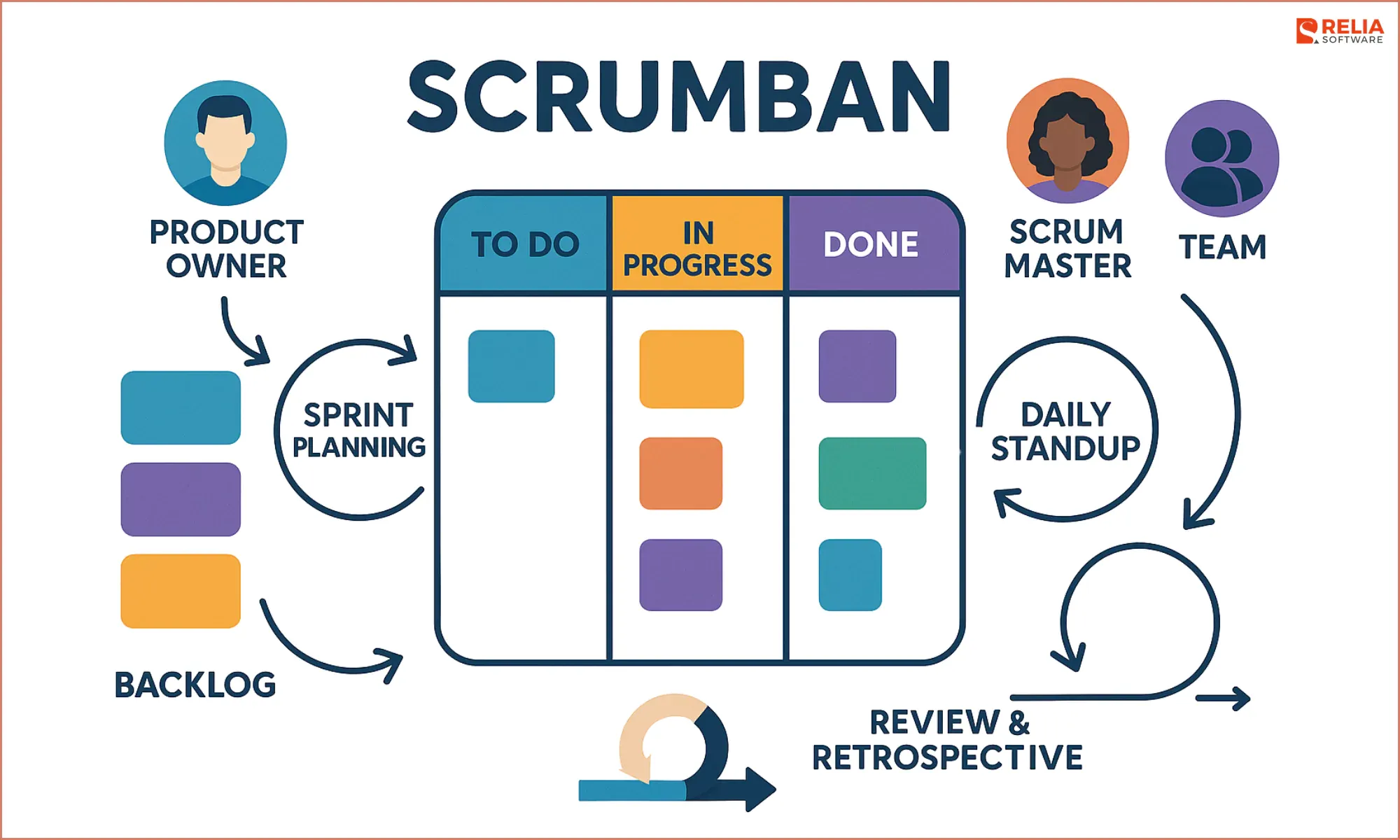
XP (for Teams)
Extreme Programming (XP) is another software development methodology that has its roots in the Agile framework. XP, like other Agile methods, promotes iterative and incremental development and rapid release cycles.
In contrast to other Agile methodologies, XP is more value-driven than it is step-based. XP's core values consist of:
- Simplicity
- Communication
- Consistent feedback
- Respect
Developers following the principles of Extreme Programming must first anticipate and comprehend user stories, which are customers' unstructured descriptions of desired features and functionality.
→ When to use XP?
Teams of programmers who wish to crank up their output and quality using a framework designed for software development would benefit greatly from XP. Since pair programming is so central to XP, teams that include both inexperienced and seasoned developers may benefit from adopting the methodology.
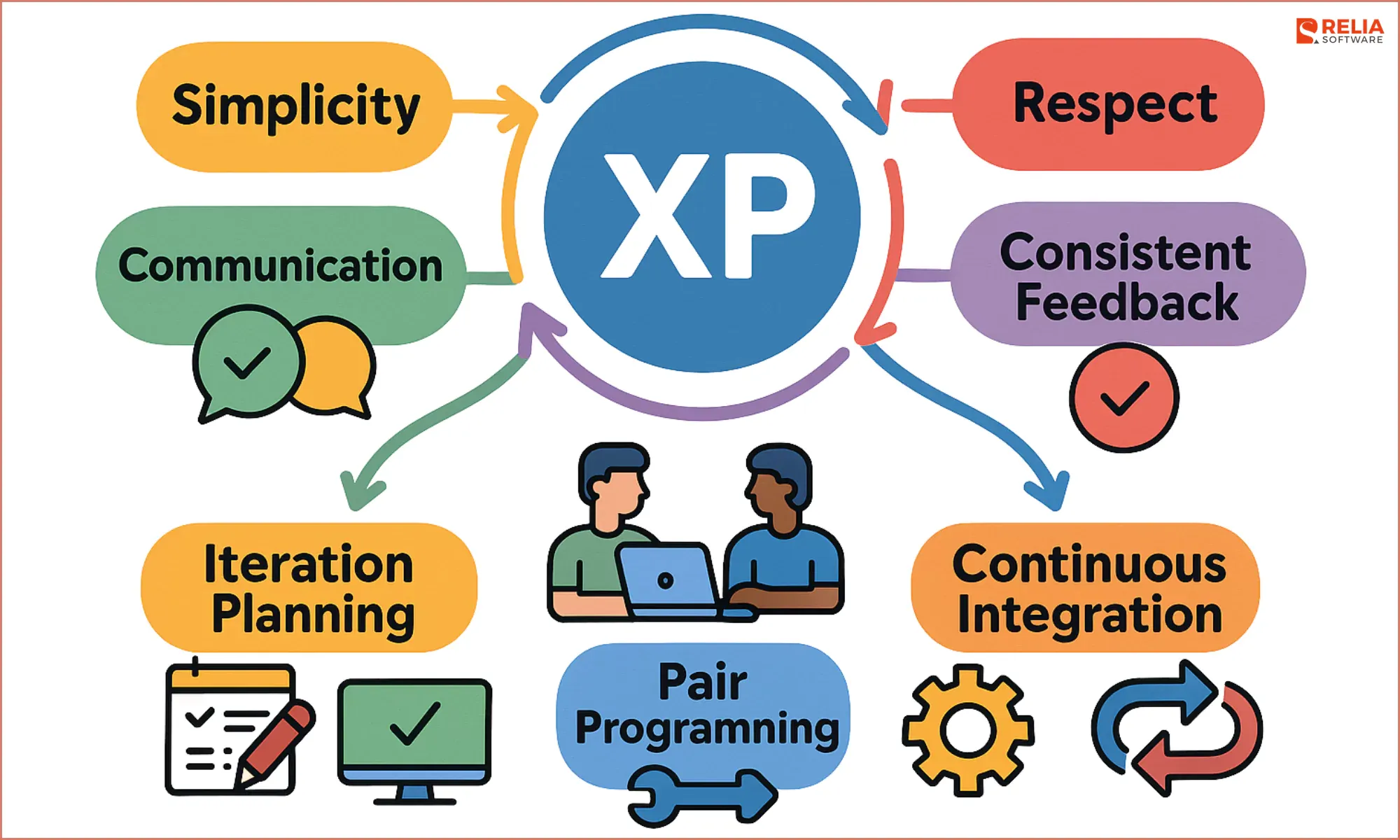
Scaled Agile Framework (SAFe) (for Organizations)
SAFe stands for Scaled Agile Framework. It is one of numerous Agile frameworks that help companies scale Agile beyond teams.
SAFe assists large enterprises in implementing, extending, and applying Agile techniques and practices across numerous teams and departments.
Practitioners used three main knowledge bases to create SAFe:
- Development of agile software
- Lean product development
- Systems thinking
SAFe's prescriptive, structured methodology helps organizations align, collaborate, maximize flexibility, and predictability across many Agile teams.
→ When to use SAFe?
SAFe works well for large firms with traditional management styles who desire to adopt a new approach. Agile Coach Jonas Lidman called it “training wheels” for Agile transformations. SAFe is a massive framework. Executives and program managers like it because it provides them a sense of control, but it can hinder team and organization agility.
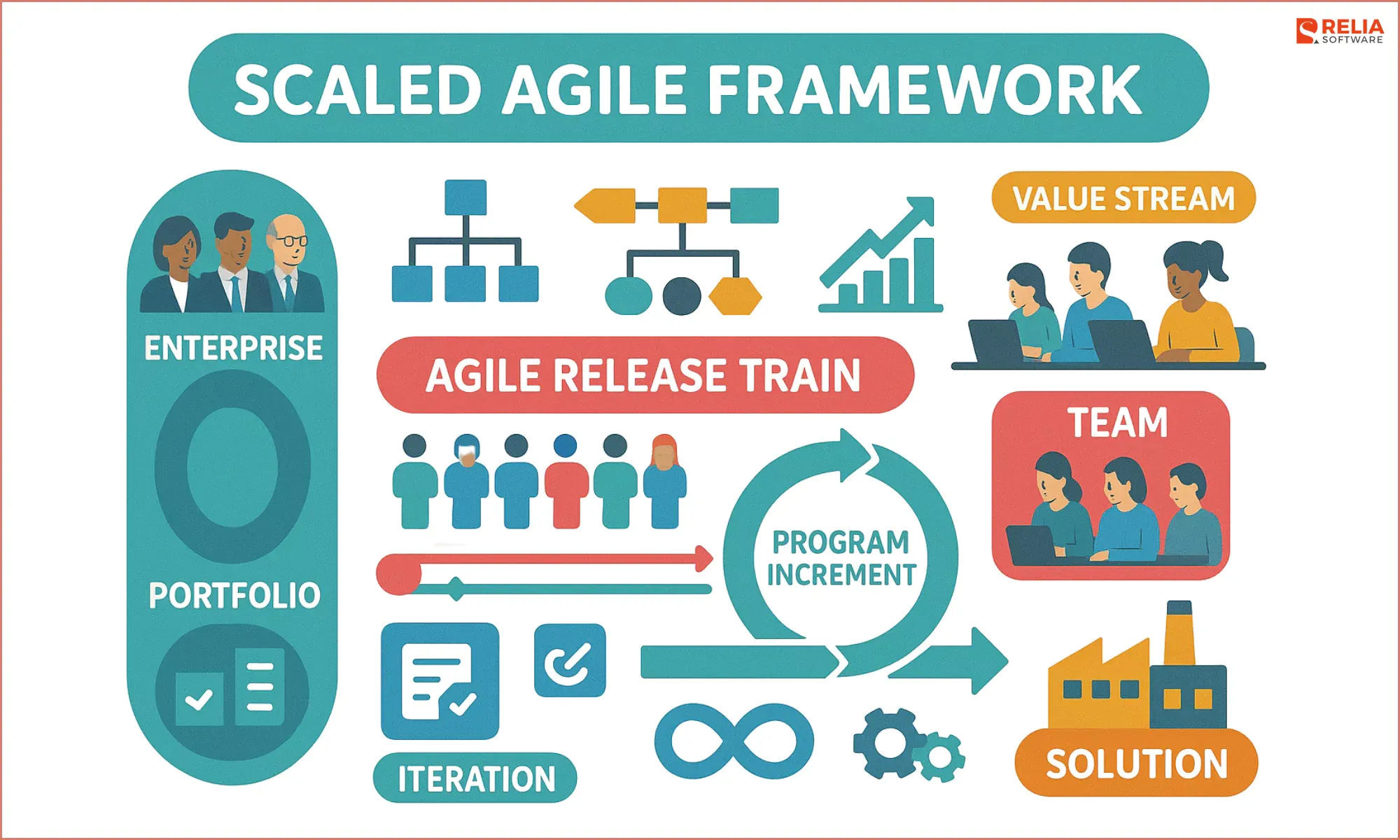
Disciplined Agile (DA) (for Organizations)
Disciplined Agile (DA) framework provides light guidance to assist teams practice Agile at scale. DA is sometimes viewed as a mashup of XP, Scrum, Kanban, and other Agile frameworks. It places an emphasis on a "people-first" methodology.
DA is best suited for companies who are already experienced with Agile because of its limited focus on teaching fundamental Agile ideas and practices. However, DA can be successful for experienced Agile businesses seeking a lightweight, hybrid strategy to scaling.
→ When to use DA?
If your company finds SAFe too cumbersome but other scaled frameworks too light, DA may be a good fit. DA's 'choose your own adventure' style of agile makes it a good fit for companies that wish to systematically improve their current agile methods.
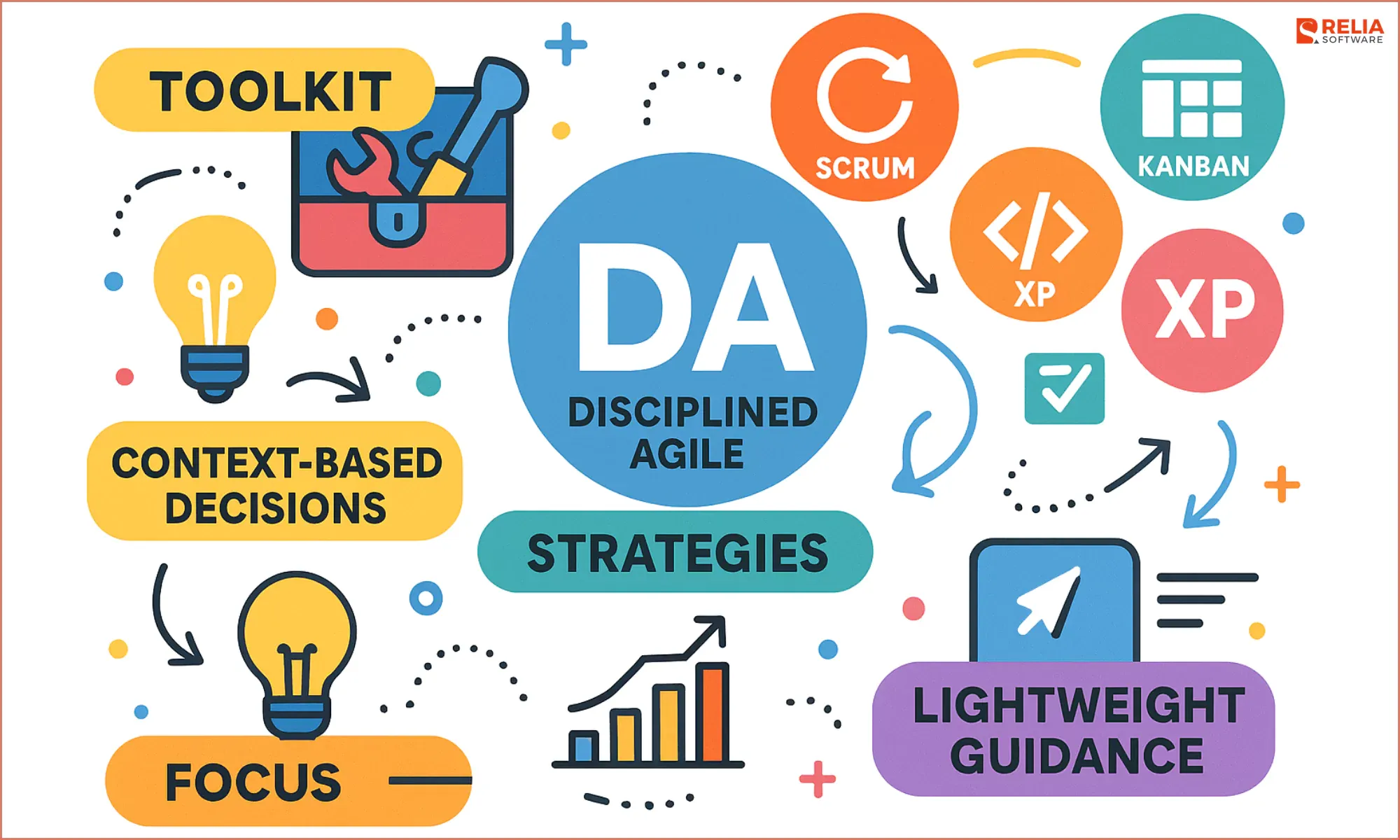
Large Scale Scrum (LeSS) (for Organizations)
Large Scale Scrum is an Agile methodology designed specifically for a single team, with few recommendations for expanding to several teams. After experiencing Scrum's benefits firsthand, many groups wonder how to take the framework to the next level without diluting its core values. Large Scale Scrum (LeSS) is one such Agile framework that may be useful for such teams.
LeSS adapts the core values of Scrum to work with numerous teams. While LeSS is a great Agile framework for teams working together on a single product or inside a single value stream, it is not the ideal choice for a company seeking to grow Agile across the portfolio.
→ When to use LeSS?
LeSS is an easy-to-use substitute for the SAFe framework. Scrum is a useful framework for organizations with multiple independent teams working together on a single product or deliverable. It facilitates Scrum's expansion.
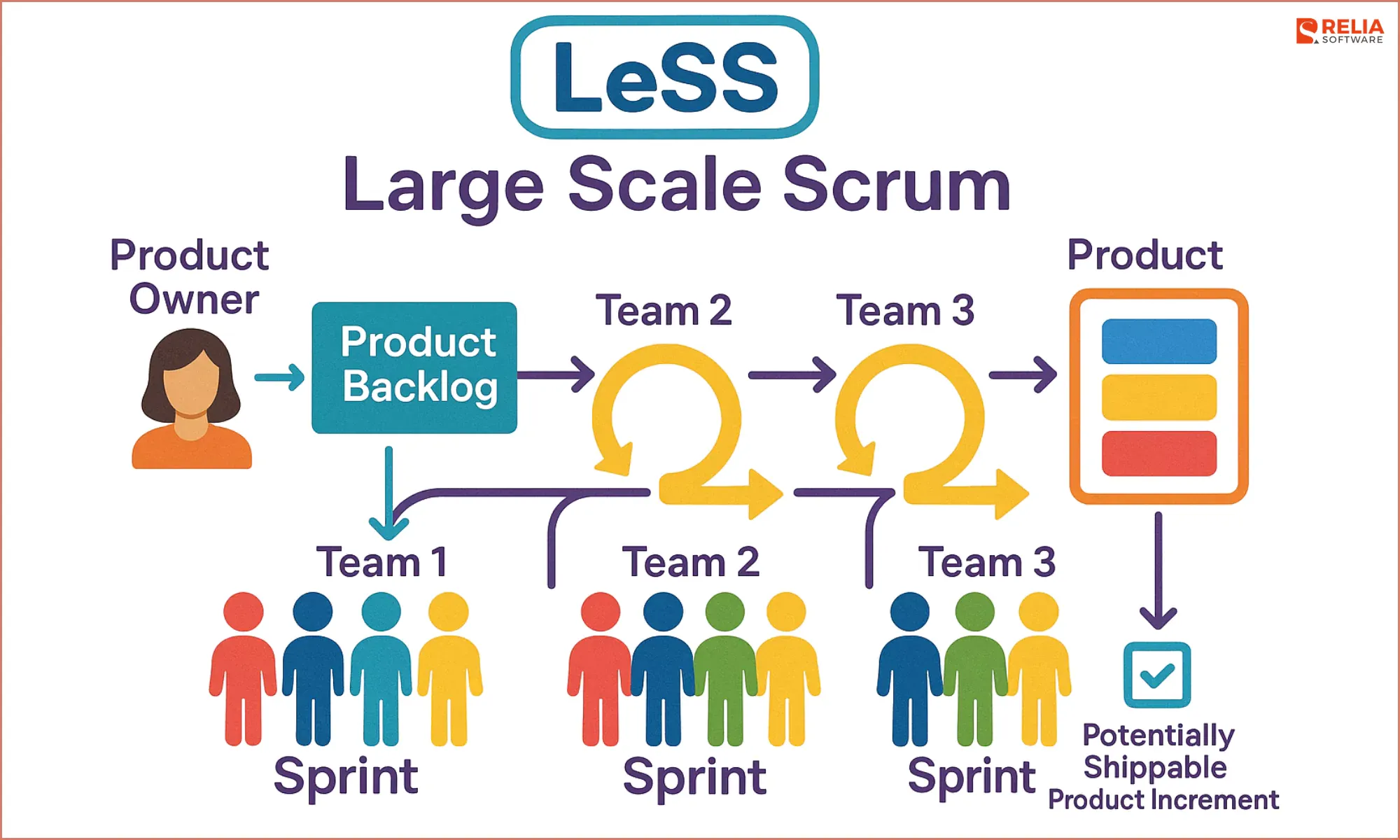
Scrum of Scrums/Scrum@Scale (S@S) (for Organizations)
Famous Agile specialist and author of the Scrum Guide Jeff Sutherland is also credited with creating Scrum@Scale, one of the Agile frameworks meant to facilitate the widespread adoption of Scrum. Components of Scrum@Scale include:
- Scrum
- Complex Adaptive Systems theory
- Game theory
- Object-oriented programming
→ When to use S@S?
Scrum of Scrums is best suited for teams that have outgrown Scrum and only require a little more coordination between them. Each team maintains their own Backlog, duties, and meetings, which makes it different from LeSS. For organizations that want to preserve Scrum as much as possible at the level of individual teams, Scrum of Scrums is an excellent option.

Spotify Model (for Organizations)
Spotify, the music-streaming service, has been credited with introducing many people to Agile. The company's adoption and subsequent popularization of a particular Agile configuration is often referred to as the Spotify Model.
The Spotify Model is an independent, people-centric strategy for expanding Agile. Technically speaking, it is not a framework but rather an exemplary case of large-scale Agile in action. Engineers at Spotify published their methodology for scaling Agile in a now-famous document titled Scaling Agile @ Spotify, which has been widely referenced by other businesses.
According to Scaling Agile at Spotify and other Agile practitioners, the Spotify Model is an early version of Scrum@Scale.
→ When to use the Spotify Model?
Since it is not unduly prescriptive while still providing adequate direction on arranging numerous teams, the Spotify Model is an excellent alternative to SAFe. It's certainly more adaptable than SAFe, allowing for Scrum and Kanban to be used by individual Squads and LeSS to be adopted by entire Tribes.
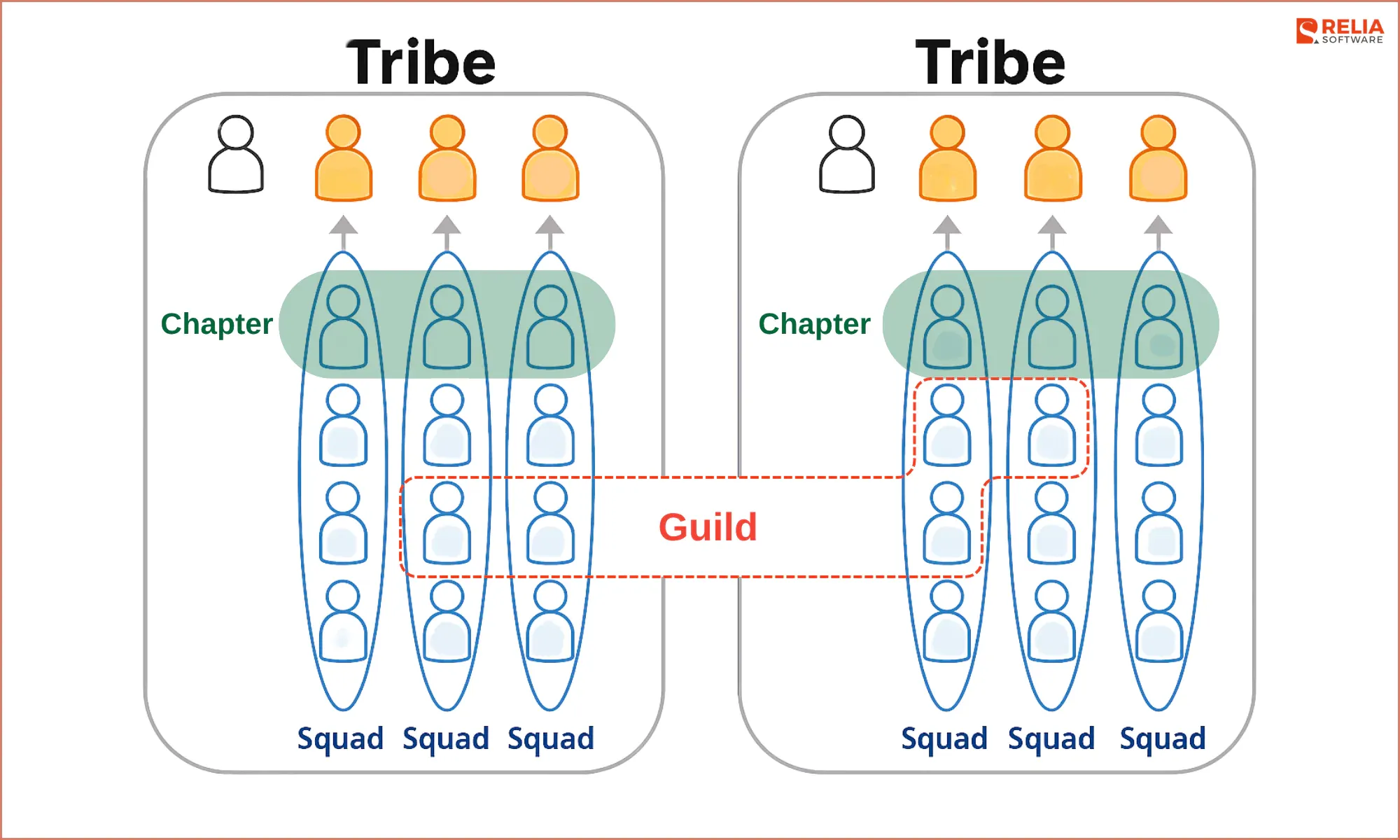
Nexus (for Organizations)
Nexus is an Agile methodology that uses Scrum as its foundation. It supports large-scale product delivery initiatives by eliminating and managing Scrum team dependencies to achieve agility.
Nexus refers to three to nine Scrum teams working together to develop a product under this scaled Agile methodology. One Product Owner handles each Nexus' Product Backlog.
Nexus' creators stick to Scrum's essential principles and merely expand it to allow numerous Scrum teams to work on a product.
→ When to use Nexus?
- A startup in need of a lightweight framework.
- Proficient in Scrum.
- Has limited financial resources.
- Build simple solutions.
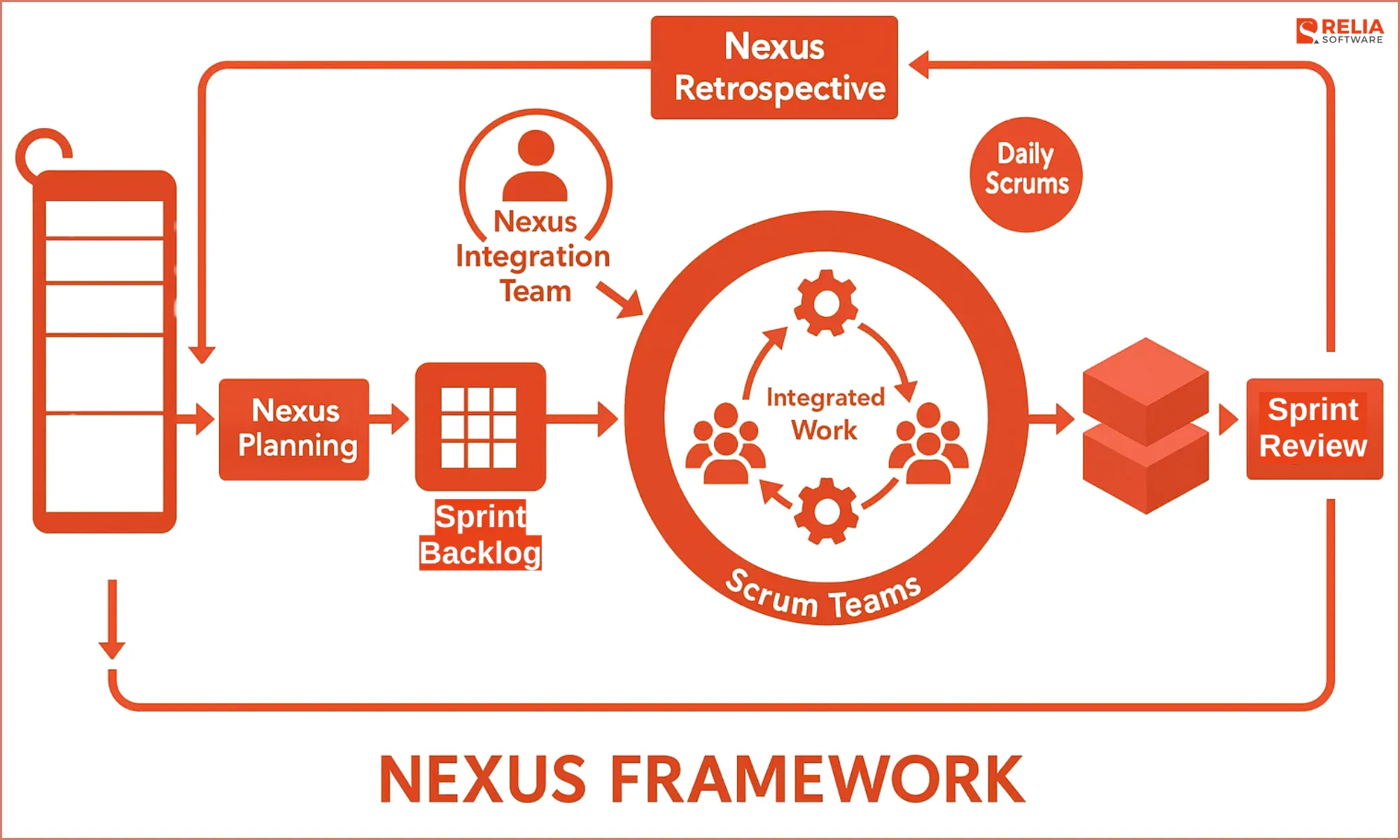
Agile Frameworks Comparison
Kanban vs Scrum
Kanban is more flexible and responsive than Scrum, which works in two-week Sprints with work items fixed based on a team's Sprint goal. Kanban lets you pull back and replace deliverables at any time.
A two-week Scrum might be restrictive, according to Agile Coach Murray Robinson. You cannot interrupt the Scrum team to do anything new if your product manager says, ‘We’ve got something urgent.’ Wait for the next Sprint. It will likely take three weeks to get to anything new.
Key distinctions between Scrum and Kanban:
| Scrum | Kanban | |
| Work Direction | Requires teams to meet goals every two weeks. | Allows the team to work without direction. |
| Work Completion | Spring Planning, Planning Poker, and other agile estimation methods help Scrum provide more accurate estimates at Sprint start. | Estimates work completion by analyzing the average work process time. |
| Work Reprioritizing | Makes it hard to reprioritize work quickly because Sprints have fixed goals. | Let stakeholders see new requests completed the same day. |
| Team Roles | Scrum Master and Product Owner are fixed roles. | Has no predetermined team roles or meetings. This freedom might confuse group and stakeholder obligations and expectations. |
SAFe vs Scrum
It's like trying to compare a truck and a car when comparing SAFe and Scrum. Both are operable vehicles, and they have comparable wheels and engines. Their functions, sizes, and modes of functioning are all very different.
Scrum is meant to be used by small, self-contained groups of three to nine people. SAFe, otherwise, takes cues from Scrum but aims to be a more comprehensive agile solution for large enterprises with hundreds or thousands of employees across a wide range of departments.
Key distinctions between SAFe and Scrum:
| Scrum | SAFe |
Target users | Scrum is most effective when used by autonomous teams in empowered, flat organizations. | SAFe is tailored to the demands of large, established businesses that are resistant to structural change. Most other Agile frameworks rely heavily on the development of team autonomy, however SAFe leaves little possibility for this. |
Characteristic | Scrum is a self-contained, lightweight framework that isn't overly prescriptive. | SAFe prescribes very explicitly what teams should do and incorporates components of Scrum and many other techniques. |
Planning Cycle | Places an emphasis on short planning and work cycles. Individual teams may use two-week Scrum Sprints | Maintains a standard quarterly planning cycle. This quarterly rhythm can soon take hold and transform into a series of three-month, fixed-scope projects. |
SAFe vs LeSS
LeSS retains all the features of traditional Scrum while adding a few refinements to make the Scrum process suitable for scaling from a single team to an entire business. SAFe seems to have evolved from more conventional management approaches with a top-down perspective, to which Agile features have been subsequently added when applicable.
LeSS, if it were a person, would be a laid-back CEO of a rapidly expanding company. SAFe, on the other hand, is the buttoned-up department head in a staid old corporation.
Key distinctions between SAFe and LeSS:
| SAFe | LeSS | |
| Characteristic | Many Agile practices are formalized by SAFe as prescriptive components. | LeSS adheres as closely as it can to Scrum's adaptable and lightweight methodology at a larger scale. |
| Target User | Traditional hierarchically controlled businesses that don't wish to change their organizational structure | Flat organizations with empowered teams |
Essential Factors for Companies to Consider When Choosing An Agile Framework
You may be asking how to narrow down the options for structuring agile processes within your firm. A universally applicable method of agile software development has yet to be discovered. There are a variety of considerations that can affect the framework selection process. Things like:
Team Size: Scrum is a good choice for small businesses with few projects because it meets their needs. But SAFe can be chosen by bigger teams.
Complexity: Projects that are hard to understand and need multiple layers of solutions need a structured and planned framework method like SAFe provides. The company would need to think about this to figure out which way is best for its project.
Team Skill: The level of team skill determines which agile framework a company picks. They can only choose a framework if their team knows how to use it well and has worked on projects using it before.
Organizational Culture: The company can go for SAFe if it keeps clients fully informed at all times. In the same way, the team's mindset determines which framework will work for them.
>> Read more: How To Manage A Software Development Team?
Conclusion
There are advantages and disadvantages to every possible framework. Another team's successful framework may not be ideal for your own. Therefore, you will need to do some experimenting to find out what is most effective for you.
>>> Follow and Contact Relia Software for more information!
Our Email: sales@reliasoftware.com
- development
- mobile applications
- web development

